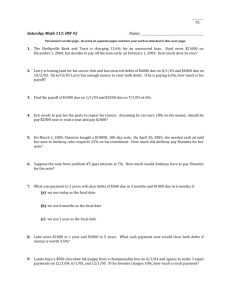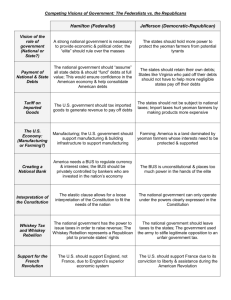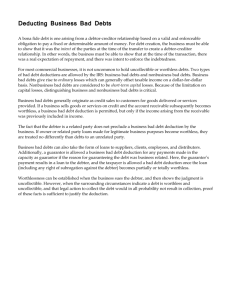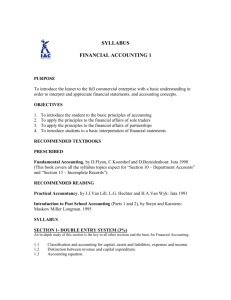consequences of rising public debts
advertisement
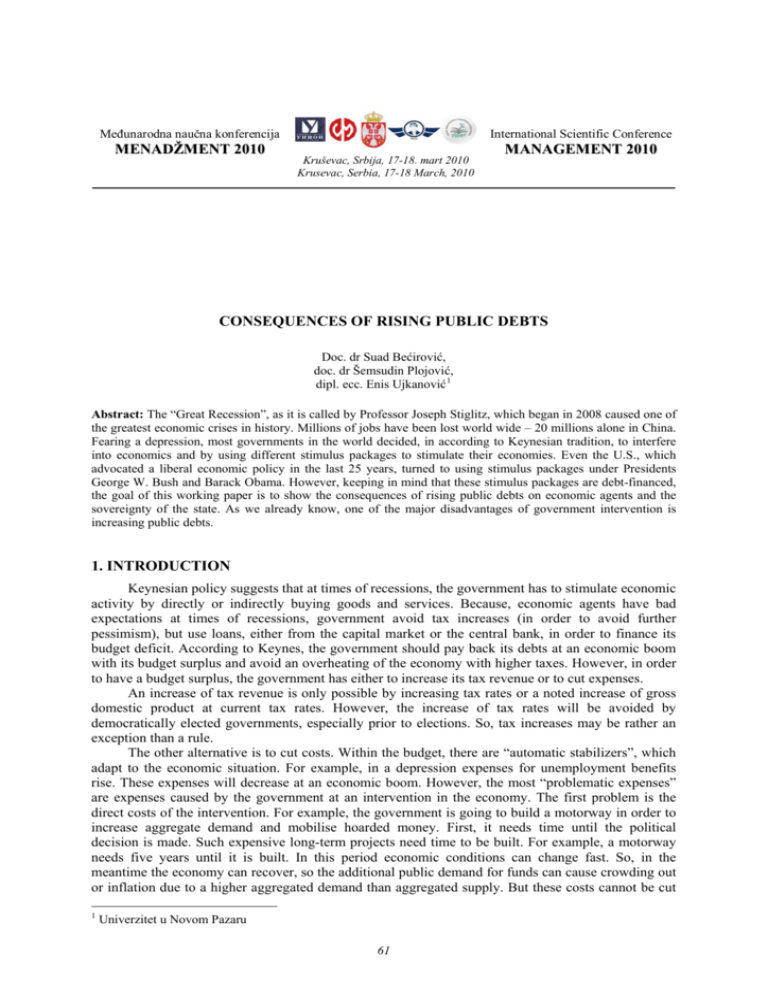
Međunarodna naučna konferencija MENADŽMENT 2010 International Scientific Conference Kruševac, Srbija, 17-18. mart 2010 Krusevac, Serbia, 17-18 March, 2010 MANAGEMENT 2010 CONSEQUENCES OF RISING PUBLIC DEBTS Doc. dr Suad Bećirović, doc. dr Šemsudin Plojović, dipl. ecc. Enis Ujkanović 1 Abstract: The “Great Recession”, as it is called by Professor Joseph Stiglitz, which began in 2008 caused one of the greatest economic crises in history. Millions of jobs have been lost world wide – 20 millions alone in China. Fearing a depression, most governments in the world decided, in according to Keynesian tradition, to interfere into economics and by using different stimulus packages to stimulate their economies. Even the U.S., which advocated a liberal economic policy in the last 25 years, turned to using stimulus packages under Presidents George W. Bush and Barack Obama. However, keeping in mind that these stimulus packages are debt-financed, the goal of this working paper is to show the consequences of rising public debts on economic agents and the sovereignty of the state. As we already know, one of the major disadvantages of government intervention is increasing public debts. 1. INTRODUCTION Keynesian policy suggests that at times of recessions, the government has to stimulate economic activity by directly or indirectly buying goods and services. Because, economic agents have bad expectations at times of recessions, government avoid tax increases (in order to avoid further pessimism), but use loans, either from the capital market or the central bank, in order to finance its budget deficit. According to Keynes, the government should pay back its debts at an economic boom with its budget surplus and avoid an overheating of the economy with higher taxes. However, in order to have a budget surplus, the government has either to increase its tax revenue or to cut expenses. An increase of tax revenue is only possible by increasing tax rates or a noted increase of gross domestic product at current tax rates. However, the increase of tax rates will be avoided by democratically elected governments, especially prior to elections. So, tax increases may be rather an exception than a rule. The other alternative is to cut costs. Within the budget, there are “automatic stabilizers”, which adapt to the economic situation. For example, in a depression expenses for unemployment benefits rise. These expenses will decrease at an economic boom. However, the most “problematic expenses” are expenses caused by the government at an intervention in the economy. The first problem is the direct costs of the intervention. For example, the government is going to build a motorway in order to increase aggregate demand and mobilise hoarded money. First, it needs time until the political decision is made. Such expensive long-term projects need time to be built. For example, a motorway needs five years until it is built. In this period economic conditions can change fast. So, in the meantime the economy can recover, so the additional public demand for funds can cause crowding out or inflation due to a higher aggregated demand than aggregated supply. But these costs cannot be cut 1 Univerzitet u Novom Pazaru 61 until the project is finished. Another expense factor is financing costs, i.e. costs for repayment and interest. For long-term projects, long-term loans will be taken. These costs cannot be cut, only if loans are repaid prior to their maturity. Because the investments are large, this is difficult to achieve and not in the interest of the creditors due to lower interest earnings. Moreover, if in the meantime public revenues fall again due to a lower economic growth, the government has to take new loans to finance old debts. So, the effect of compound interest increases debts. Another problem with cost cutting is that it is difficult to cut subsidies, cancel projects on a political basis, due to the bargaining power of pressure groups. Governments cannot afford that influential pressure groups turn against them, because they fear they will lose the next elections. The inability to cut expenses leads to a continuous growth of debts. The phenomenon of growing debts can be observed in industrialised countries, which implemented Keynesian policies. Illustration 1 shows that national debts are already high and rising again in many industrialised countries. The graph shows that especially Japan has a high national debt. For example, national debt was only at 61.1% of GDP in 1991, but rose to 161.9% in 2005. 2 The reason for such a rapid growth of debt is that the Japanese government hoped to increase the growth of GDP by government expenditures during the 1990s, i.e. by implanting a Keynesian policy. But up to now, this strategy had only limited success, but debt and interest expenses are growing. Also the U.S. debts are growing. The main reason for this growth is that since 2001 the BushAdministration is trying to boost the American economy with deficit spending. Another reason for the higher deficit is the high costs for the military. So, this government policy will lead to a further increase in U.S. government debts. However, the USA have already a deficit in its trade balance, a low saving quota and a high foreign debt, which will cause the USA a lot of problems, if there will be no adequate economic growth. 3 170,0 160,0 150,0 140,0 130,0 120,0 110,0 100,0 90,0 2000 80,0 2005 70,0 60,0 50,0 40,0 30,0 20,0 10,0 0,0 GER EU USA JPN Illustration 1: Debts in Percent of the Gross Domestic Product in Germany, the European Union, USA and Japan in 2000 and 2005 Source: Meyer, D., Die Schuldenfalle - eine Untersuchung der Staatsverschuldung ab 1965 bis 2025 The ratio between debts and GDP is an important measure to analyse government’s finances. Because GDP is a measure of the government’s tax base, a declining debt-GDP ratio indicates that the government indebtedness is shrinking relative to its ability to raise taxes. In such a case the government has a healthy finance management. However, if the debt-GDP ratio rises, then the 2 Meyer, D., Die Schuldenfalle - eine Untersuchung der Staatsverschuldung ab 1965 bis 2025, article at: http://www.staatsverschuldung-schuldenfalle.de/ 3 Ibid 62 government indebtedness is increasing relative to its ability to raise tax revenue. Such a government policy cannot be sustained for a long period and will possibly lead to a debt crisis. 4 Especially, if it is possible to finance debts with new debts, the debt problem is postponed to future generations. How such high debts develop, we will investigate on the example of Germany. Germany is a good example, because it began after the Second World War from the beginning, i.e. without national debts. So, we can see how public debts developed in a period of 60 years. Illustration 2 shows the development of public revenue and debts in Germany. The graph clearly states that national debt is growing faster than income, so debts constitute a major part of the gross domestic product. For example, the budget deficit in Germany in 2005 was 74.3 billion Euros. Interest expenses accounted 64 billion Euros and state income was 453 billion Euros in the same period, so the “interest tax” 5 was 14.1% in 2005. 6 This means 14.1% of the public revenues were used for interest payments. This constitutes a major burden for the government and decreases the flexibility in using revenues for other projects. These numbers also show how fast national debts are growing, so these debts cannot be repaid with a short-term growth in the gross domestic product. A long-term strategy would be necessary to repay the accumulated debts. Therefore, repayment of debts has to be financed with new loans, which lead to increasing interest expenses. Illustration 2: Development of Public Revenues and Debts in Germany (Numbers in Billion DEM) Source: Creutz, H., Globalisierung und Gemeinwohl vor dem Hintergrund der Geld- und Bodenordnung, p. 5 Period 1965 – 1980 1981 – 2005 1965 – 2005 New Debts 196.8 1,097.2 1,294.0 Interest Expenses 103.7 1,213.7 1,317.4 4 (New Debts) – (Interest Expenses) 93.1 -116.5 -23.4 Mankiw, N. G., Principles of Macroeconomics, 3rd edition, South-Western, 2004, p. 285 The “interest tax” shows how much of the state income had to be used for payment of interest. 6 Meyer, D., Die Schuldenfalle - eine Untersuchung der Staatsverschuldung ab 1965 bis 2025 5 63 Illustration 3: Comparison of New Debts and Interest Expenses in the National Budget of Germany (Numbers in Billion DEM) Source: Meyer, D., Die Schuldenfalle - eine Untersuchung der Staatsverschuldung ab 1965 bis 2025 Illustration 3 shows an interesting development of national debts in Germany. In the period between 1965 and 1980, new debts were higher than the accumulated interest expenses. This shows that new debts were used to finance projects. But in the period between 1981 and 2005 interest expenses were higher than debts. In this period, new debts were actually used for interest payments and even the new debts were not enough to finance interest payments, but further funds from the public revenues were necessary in order to finance interest payments. So, the new debts could not be used to finance new projects. Analysing the whole period from 1965 to 2005, we can see that interest payments are higher than new debts. On the whole, these new debts were only used to finance interest payments. The German example shows that old debts have accumulated over time and over a long-term new debts and a growing part of public revenues have to be used for debt repayment. So the question arises whether such a high national debt was really necessary and causes more harm than benefits? 2. CONSEQUENCES OF DEBT-BASED FINANCING If there is not enough demand for money in the capital markets, which could lead to a deflation, the government has to ask for money in order to avoid hoarding of money. This policy will again lead to a rise in interest rates (see illustration 4). So, for money holders a budget deficit is positive when there is not a sufficient demand for money. On the other hand, if the demand for money is on a high level (e.g. in a boom), but government has already high debts and needs funds to repay debts and for interest payments, government demand leads to an increase of already high interest rates due to a brisk private demand for funds. The increase in interest rates leads to a decrease of private investments, due to higher interest rates because of government borrowing, the so-called crowding out. 7 Interest Rate (i) Demand for Money Supply of Money i1 i0 C0 C1 Capital (C) Illustration 4: Influence of Government Demand for Additional Funds on the Interest Rate Source: Own Illustration The major problem at national debt is the compound interest. Compound interest forces governments to take new loans to finance interest expenses and loan repayment. So deficit financing will be a continuous phenomenon. We have to keep in mind that budget deficit is a cumulative value, which leads to an increase of national debt. So, national debts rise continuously and lead to growing expenses for loan repayment and interest expenses. Theoretically, the exponential growth of debts 7 See Mankiw, N. G., Principles of Macroeconomics, 3rd edition, South-Western, 2004, p. 283 64 could be stopped with an exponential growth of GDP, i.e. interest rates and growth rates of GDP have to have the same value. However, an exponential growth of GDP is impossible, due to limited national resources and a limited market potential. Furthermore, government intervention at a recession leads to a further accumulation of debts. In such a situation the government has to ask for goods and services of the private sector in order to stimulate economic growth. This leads again to higher debts and therefore to higher expenses for debt repayment and interest. But, no government is able to sustain financing a deficit over a longer period. Therefore, the government will have to think about solving its financial problems. To solve these problems, the government has the following alternatives: - Increasing taxes - Decreasing expenditures - Inflation The first alternative to get rid of government debts is increasing taxes. However, in many developed countries the possibility to raise taxes is already limited due to high existent taxes, especially indirect taxes (e.g. value added taxes, petroleum taxes). First of all, it has to be kept in mind that increasing taxes lead to the avoidance of paying taxes and therefore to lower tax revenues. Furthermore, high taxes lead to location disadvantages, therefore companies might avoid investing in the country anymore. But, in general, tax revenues can only increase slowly due to a limited growth of GDP, especially in developed countries. So, tax increases are only efficient in countries with a high growth of GDP. But the negative effects of tax increases on economic growth have to be considered. Another alternative is cutting expenditures. This is an unavoidable measure. However, the first victims of such cuts will be groups which do not have a strong lobby and therefore no strong political protection. Under this group fall the poor and social weak. The third alternative for decreasing government debt is inflation. If the central bank is under direct or indirect control of the government, the government could ask the central to buy government bonds and in this way give the government new money. This additional amount of money will on the long-term lead to inflation. Inflation is beneficial for the borrower, because it leads to a fall of the real value of debt. On the other hand, inflation will lead to a decrease of aggregate saving due to higher prices and a higher level hoarding due to a lower real interest rate. In order to attract more savings, financial institutions will have to increase the real interest rate, which will again lead to a redistribution of wealth from lower-income groups to high-income groups. With the exception of tax increases, all alternatives in order to decrease national debt will benefit wealthy people. So, on the long-term this will lead to a concentration of wealth into a few hands. In order to finance new debts, the government will have to borrow funds from these individuals. So, there lobbying power will increase and the government will have to execute a policy which will be in the interest of this group. Therefore, the government will avoid increasing taxes for wealthier people. So, in fact the state will become more and more dependent from a small number of individuals and lose its independence. 3. CONCLUSION Increasing tax rates or decreasing expenditures are generally unpopular measures. But, as our discussion has shown, financing old debts with new debts is not a realistic solution over the long-term. According to our opinion, governments should not be allowed to take interest-based loans. The disadvantage of interest-based loans is that the government receives money, which it can also use for inefficient measures. The non-availability of interest-based loans will force the government to a more responsible financing policy. It is generally accepted in economics that it is rational to borrow money for a house or car, because these assets will be used over a longer period of time. Here payments will be distributed over a longer period of time for an asset which has a long-term usufruct. However, if a loan is taken to finance short-term expenses over a longer period, e.g. for wages, energy costs, then such loans are inefficient. 8 Therefore, if debt-based contracts are applied in public finance, these 8 Stiglitz, J. E., Volkswirtschaftslehre, 2nd edition, Oldenbourg, 1999, p. 1044, 1045 65 should be organised for example in the form of leasing contracts or sales on credit, which are bound to a physical asset. If something is used as physical asset, we can expect that there is a real need for such expenditure. State funded investments can be organised by a state-owned development bank with a high degree of independence (as for example the Central bank). In this case, growing industries with real potential should be supported. But industries which are inefficient should not be supported or companies, where individual politicians have some interests due to other considerations. But, in general, we can say that an efficient auditing of public finances is indispensable in order to control the efficient use of public finances. 4. REFERENCES [1] Bećirović, S., Interest – a comparative study about monetary and financial systems, doctoral thesis at the University of Novi Pazar, Novi Pazar, 2009. [2] Stiglitz, J. E., Volkswirtschaftslehre, 2nd edition, Oldenbourg, Munich, 1999. [3] Mankiw, N. G., Principles of Macroeconomics, 3rd edition, South-Western, 2004. [4] Meyer, D., Die Schuldenfalle - eine Untersuchung der Staatsverschuldung ab 1965 bis 2025, article at: http://www.staatsverschuldung-schuldenfalle.de/ [5] Keynes, J. M., The General Theory of Employment, Interest and Money, Project Gutenberg edition, book at http://biblioeconomicus.googlepages.com/KeynesJohnMaynardTheGeneralTheoryOfEmploymentInterestAndMoney.pdf 66
